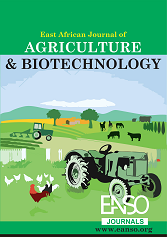Impact of Different Drip Emitter Types on Hydraulic Performance and Wetted Zone Characteristics in Okra Cultivation
الملخص
Drip irrigation system is the most efficient and economical method for irrigation vegetable production. The study aimed to design and evaluate the hydraulic performance of three different types of emitter namely Regular gauge (RG), Compensating pressure (CP) and non-compensating pressure (NCP) using okra as a test of a crop. This study was conducted at the experimental farm of the Faculty of Agricultural Science, Zamzam University in 2023. The treatments were laid out in a randomized complete block design (RCBD) with three replications. Parameters of hydraulic performance of drip emitters were average discharge (Qavg %), discharge variation (Qvar), coefficient uniformity (CU %), coefficient of manufacture variation (CV), emission uniformity (EU %) and statistical uniformity (US %). The results showed that the values of (CU%), (CV), (EU%), (US%) and percentage emitters clogging (Pclog%) were 99.52%, 0.49, 68.01%, 74.14%, 2.8% and 99.32%, 0.36, 52.06%, 63.47%, 1.65% and 99.09%, 0.26, 40.07%, 51.05%, 0.85% for non-compensating pressure (NCP), compensating pressure (CP) and regular gauge (RG respectively. It is considered coefficient uniformity (CU %), was good and found to be within the excellent range while discharge variation (Qvar) was found to be within the desirable range, emission uniformity (EU %), coefficient of manufacture variation (CV), and statistical uniformity (Us %) were found to be within the range of poor, low, acceptable and unacceptable. Thus, the study recommended the best type of emitter was regular gauge (RG), because it has the highest crop yield and water productivity as compared to other emitters, non-compensating pressure emitters (NCP) and compensating pressure emitters (CP)
التنزيلات
المراجع
Almajeed, M. A., &Alabas, A. (2013). Evaluation the Hydraulic Performance of Drip Irrigation System with Multi Cases. http://creativecommons.
ASAE, 2003. Field evaluation of micro irrigation systems. EP458. American Society of Agricultural Engineers, St. Joseph, 760−765.
Bralts, V. F., and Kesner, C. D. (1983). Drip irrigation field uniformity estimation. Transactions of the ASAE, 26(5), 1369-1374.
Bralts, V. F., Edwards, D. M., & Wu, I. P. (1987). Drip irrigation design and evaluation based on the statistical uniformity concept. Advances in irrigation, 4, 67-117.
Christiansen, J.E. (1942). Irrigation by sprinkler, Berkeley, California Agricultural station,124P. (Bul670)
D. Sathish kumar. (2013). A review on Abelmoschus Esculentus Okra. Chalapathi institute of pharmaceutical science, Guntur, Andhra Pradesh, India.
Farah, A. A. U. (2023). Evaluation of hydraulic performance of three different emitters in drip irrigation system for small vegetable farms, Gezira State, Sudan. International journal of agriculture and nutrition 11-15.
Grubben, G. J. H. & Denton, O. A. (eds) 2004. Plant resources of Tropical Africa 2
Guguloth, P., 2016. Hydraulic performance evaluation of drip irrigation system for cabbage (Brassica oleracea L). MSc Thesis. Professor Jaya Shankar Telangana State Agricultural University.
Hisham M, Mohammed, Elwaleed Hassan, Ahmed S. Ahmed and Huda A.Mohammed. (2022). Hydraulic performance of different emitters under varying water tank
Karam, F., Masaad, R., Bachour, R., Rhayem, C., and Rouphael, Y. (2009). Water and radiation use efficiencies in drip-irrigated pepper (Capsicum annuum L.): response to full and deficit irrigation regimes. European Journal of Horticultural Science, 79-85.
Keller, J. and Bliesner, R.D. (1990). Sprinkler and Trickle Irrigation, Van Nostrand Reinhold, New York,
Kirnak H. Erg.n Douan, Syddyk Demur and Sabri Yalcin (2014). Determination of hydraulic performance of trickle irrigation emitters used in irrigation systems in the Harran Plain. Turk Journal of Agricultural. 28(2014) 223-230.
Kumasi, T. C., and Asenso-Okyere, K. (2011). Responding to land degradation in the highlands of Tigray, Northern Ethiopia. International Food Policy Research Institute, 1142, 44
Merriam, J. L., and Keller, J. (1978). Farm irrigation system evaluation: A guide for management. Farm irrigation system evaluation: a guide for management.
Michael, A. M. (1978). Irrigation: theory and practice. Vikas publishing, T.L.T.D. New Delhi India.
Muse, A. M. Y. (2018). Construction and Performance Evaluation of a Drip Irrigation System for Small Vegetable Farms, Gezira State, SudanPatel, N., & Rajput, T. B. S. (2008). Effect of drip tape placement depth and irrigation level on yield of okra (Abelmoschus esculentus L.). Irrigation Science, 26(6), 517- 528. DOI:10.1007/s00271-008-0114-1
Sharu, E. H., & Ab Razak, M. S. (2020). Hydraulic performance and modeling of pressurized drip irrigation system. Water (Switzerland), 12(8). https://doi.org/10.3390/w12082295
Topcu, S., Kirda, C., Dasgan, Y., Kaman, H., Cetin, M., Yazici, A., and Bacon, M. A. (2007). Yield response and N-fertiliser recovery of tomato grown under deficit irrigation. European Journal of Agronomy, 26(1), 64-70.
الحقوق الفكرية (c) 2024 Ahmed Abdulrazak Ugas Farah, Yahye Abdullahi Isse, Abdiwahab Abdullahi Omar, Osman Mohamed Hussein, Abdihakim Hassan Sh. Mohamed, Abukar Ali Shirwa, Abas Abdullahi Aday

هذا العمل مرخص حسب الرخصة Creative Commons Attribution 4.0 International License.




























